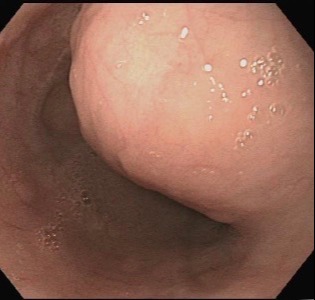Back
Poster Session D - Tuesday Morning
D0249 - A Rare Case of a Large Esophageal Gastrointestinal Stromal Tumor
Tuesday, October 25, 2022
10:00 AM – 12:00 PM ET
Location: Crown Ballroom

Andrea Fernandez, MD
University of Oklahoma Health Sciences Center
Oklahoma City, OK
Presenting Author(s)
Andrea Fernandez, MD, Evgeny Idrisov, MD, Donald Kastens, MD
University of Oklahoma Health Sciences Center, Oklahoma City, OK
Introduction: Gastrointestinal stromal tumors (GISTs) are rare mesenchymal neoplasms, accounting for approximately 1 to 2 percent of primary gastrointestinal (GI) cancers. Presenting symptoms include abdominal pain, nausea, vomiting, early satiety, bleeding, and dysphagia, but vary depending on primary tumor location. Most tumors are discovered incidentally with the majority found in the stomach (40 to 60 percent) followed by small bowel (25-30 percent), colon and rectum (5-15 percent). We present a case of an elderly patient diagnosed with esophageal GIST after he was found to have an incidental esophageal mass on imaging.
Case Description/Methods: 80-year-old male with PMH of HTN, HLD, DM2, CKD Stage III, COPD, former tobacco user was referred for an upper endoscopy for evaluation of an incidental finding on CT scan. CT demonstrated a mass arising from the distal esophagus, measuring 6.5 x 7.5 cm. Patient denied any dysphagia, abdominal pain, nausea, vomiting, weight loss, hematemesis, or melena. Endoscopy showed submucosal mass in the distal esophagus. Biopsy was inconclusive and subsequent EUS-guided fine needle biopsy was performed. Upper endoscopic ultrasound (EUS) showed an intramural lesion in the distal esophagus arising from the muscularis propria. Pathology results confirmed GIST, positive for CD117 and DOG-1. Further testing revealed a mutation in the KIT gene exon 11. Patient is currently undergoing neoadjuvant therapy with imatinib mesylate with anticipated surgical resection.
Discussion: This is a rare case of a large esophageal GIST. Most mesenchymal esophageal tumors are leiomyomas, and GIST only accounts for 0.7% of them. EUS with fine need aspiration biopsy is the most accurate method for diagnosis and definite diagnosis is made histologically. Majority of GISTs, expresses the CD117 antigen, a KIT receptor tyrosine kinase. Another commonly found mutation is the platelet derived growth factor (PDGFRA) tyrosine kinase gene. Tumor size and mitotic rate are used for prognostication, with increased malignancy risk seen in tumor size > 3 cm with irregular margins. Tumor location is also a key factor in risk stratification; non gastric primary location has higher rates of metastases. Liver and peritoneum are the most common sites of metastatic GISTs. Treatment focuses on surgical resection and neoadjuvant therapy with imatinib. Given significant implication for its management, esophageal GIST should be considered in differential diagnosis and distinguished from more common esophageal leiomyomas.

Disclosures:
Andrea Fernandez, MD, Evgeny Idrisov, MD, Donald Kastens, MD. D0249 - A Rare Case of a Large Esophageal Gastrointestinal Stromal Tumor, ACG 2022 Annual Scientific Meeting Abstracts. Charlotte, NC: American College of Gastroenterology.
University of Oklahoma Health Sciences Center, Oklahoma City, OK
Introduction: Gastrointestinal stromal tumors (GISTs) are rare mesenchymal neoplasms, accounting for approximately 1 to 2 percent of primary gastrointestinal (GI) cancers. Presenting symptoms include abdominal pain, nausea, vomiting, early satiety, bleeding, and dysphagia, but vary depending on primary tumor location. Most tumors are discovered incidentally with the majority found in the stomach (40 to 60 percent) followed by small bowel (25-30 percent), colon and rectum (5-15 percent). We present a case of an elderly patient diagnosed with esophageal GIST after he was found to have an incidental esophageal mass on imaging.
Case Description/Methods: 80-year-old male with PMH of HTN, HLD, DM2, CKD Stage III, COPD, former tobacco user was referred for an upper endoscopy for evaluation of an incidental finding on CT scan. CT demonstrated a mass arising from the distal esophagus, measuring 6.5 x 7.5 cm. Patient denied any dysphagia, abdominal pain, nausea, vomiting, weight loss, hematemesis, or melena. Endoscopy showed submucosal mass in the distal esophagus. Biopsy was inconclusive and subsequent EUS-guided fine needle biopsy was performed. Upper endoscopic ultrasound (EUS) showed an intramural lesion in the distal esophagus arising from the muscularis propria. Pathology results confirmed GIST, positive for CD117 and DOG-1. Further testing revealed a mutation in the KIT gene exon 11. Patient is currently undergoing neoadjuvant therapy with imatinib mesylate with anticipated surgical resection.
Discussion: This is a rare case of a large esophageal GIST. Most mesenchymal esophageal tumors are leiomyomas, and GIST only accounts for 0.7% of them. EUS with fine need aspiration biopsy is the most accurate method for diagnosis and definite diagnosis is made histologically. Majority of GISTs, expresses the CD117 antigen, a KIT receptor tyrosine kinase. Another commonly found mutation is the platelet derived growth factor (PDGFRA) tyrosine kinase gene. Tumor size and mitotic rate are used for prognostication, with increased malignancy risk seen in tumor size > 3 cm with irregular margins. Tumor location is also a key factor in risk stratification; non gastric primary location has higher rates of metastases. Liver and peritoneum are the most common sites of metastatic GISTs. Treatment focuses on surgical resection and neoadjuvant therapy with imatinib. Given significant implication for its management, esophageal GIST should be considered in differential diagnosis and distinguished from more common esophageal leiomyomas.

Figure: Submucosal mass in distal esophagus
Disclosures:
Andrea Fernandez indicated no relevant financial relationships.
Evgeny Idrisov indicated no relevant financial relationships.
Donald Kastens indicated no relevant financial relationships.
Andrea Fernandez, MD, Evgeny Idrisov, MD, Donald Kastens, MD. D0249 - A Rare Case of a Large Esophageal Gastrointestinal Stromal Tumor, ACG 2022 Annual Scientific Meeting Abstracts. Charlotte, NC: American College of Gastroenterology.
